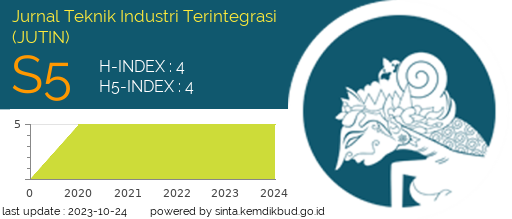PENGARUH SHIFT KERJA TERHADAP KELELAHAN PEKERJA PABRIK SAWIT DI PTPN V SEI GALUH
DOI:
https://doi.org/10.31004/jutin.v1i2.323Keywords:
kerja dua shift, ergonomis, kelelahanAbstract
Workers who work the night shift have a tendency to get stressed and subsequently suffer from fatigue as a clinical symptom. This study aims to formulate an effective strategy of policy to emphasize the reduction in the effect of applying work shifts to the risk of fatigue. Based on the results that the average amount of reactive time for morning shift workers is 0.97 seconds, while for night shift workers is 1.18 seconds. The average amount of blood systole pressure for morning shift workers is 119.22 cm Hg, while for night shift workers is Hg 127.61 cm. The average amount of blood diastole pressure for morning shift workers was 77.44 cm Hg, while for night shift workers it was 82.16 cm Hg. The average heart rate for morning shift workers was 73.93, while for night shift workers it was 76.18. Based on the results of a statistical examination that there is a significant effect on fatigue (p = 0,000), it means that there is a significant relationship between work shifts and stress-causing fatigue (p = 0,000). Therefore, as the proposal of this study and to anticipate the reduction in fatigue, it is important to make improvements and evaluations about the rules of work shifts in a company so that night shift workers can work in safe conditions and rest well after workReferences
Chew, D.C.E. 1991. Productivity and Safety and Health. Third edition. ILO. Geneva.
Christensen, E.H. 1991. Physiology of Work. Encyclopaedia of Occupational Healthand Safety, Third (revised) edt. ILO.Geneva.
Cooper, C.L. dan Payne, R. 1988.Causes, Coping and Consequences of Stress at Work, New York, Wiley.
Dekker, D.K, Tepas,D.I dan Colligan, M.J. 1996. The Human Factors Aspects of Shift Work. New York.
Djojodibroto, R.D. 1999. Kesehatan Kerja di Perusahaan, PT. Gramedia Jakarta.
Grandjean, E. 1993. Fitting the Task to the Man. 4th edition. London.
Helander, M. 1995. A Guide to the Ergonomics of Manufacturing, Taylor & Francis Great Britain. International Labour Organization, Encyclopedia of Occupational Health and Safety. 1983. Vol II.
International Labour Office, Geneva. Knauth. P. 1988. The Design of Shift Systems, International Journal of Industrial Ergonomics. Vol. 3.
McCormick, E.J and Ilgen. 1985. Industrial and Organization Psychology, Eight Edition. Prentice- Hall Englewood Cliffs, New Yersey.
Monk,T. and Folkard S. 1983. Circadian Rhythm and Shift Work, John Wiley Sons, New York.
Nurmianto, E. 2004. Ergonomi Konsep Dasar dan Aplikasinya. Penerbit Guna Widya. Edisi Kedua. Surabaya.
Pheasant, S. 1991. Ergonomics, Work and Health. Mac Millan Academic and Profesional Ltd. London.
Plog, B.A. 1995. Fundamentals of Industrial Hygiene. The National Safety Council.USA.
Pulat, B.M. 1992. Fundamental of Industrial Ergonomics, Prentice Hall, Englewood Cliffs. New Jersey. USA.
Rodahl, K. 1989. The Physiology of Work. Taylor & Francis Ltd. Great Britain.
Sanders, M.S. and McMormick, E.J. 1987. Human Factors in Engineering and Design, Sixth ed. McGraw-Hill Book Company.
Schultz, D.P. Psychology and Industry Today, An Introduction to Industrial and Organizational Psychology, 1982. Third Edition, Macmillan Publishing Co. Inc., New York.
Setyawati, L. 1996. Relation Between Feelings of Fatique, Reaction Time and Work Productivity. Journal of Human Ergonomy. 25(1): 129–134.
Singleton, W.T. 1972.Introduction to Ergonomics, WHO. Geneva.
Suma’mur, P.K. 1993. Ergonomi untuk Produktivitas Kerja. Yayasan Swabhawa Karya. Jakarta.
___. 1984. Higiene Perusahaan dan Keselamatan Kerja. Cetakan ke-4. Penerbit Gunung Agung. Jakarta.
___. UU No. 13 Tahun 2003 tentang ketenagakerjaan. Jakarta.



